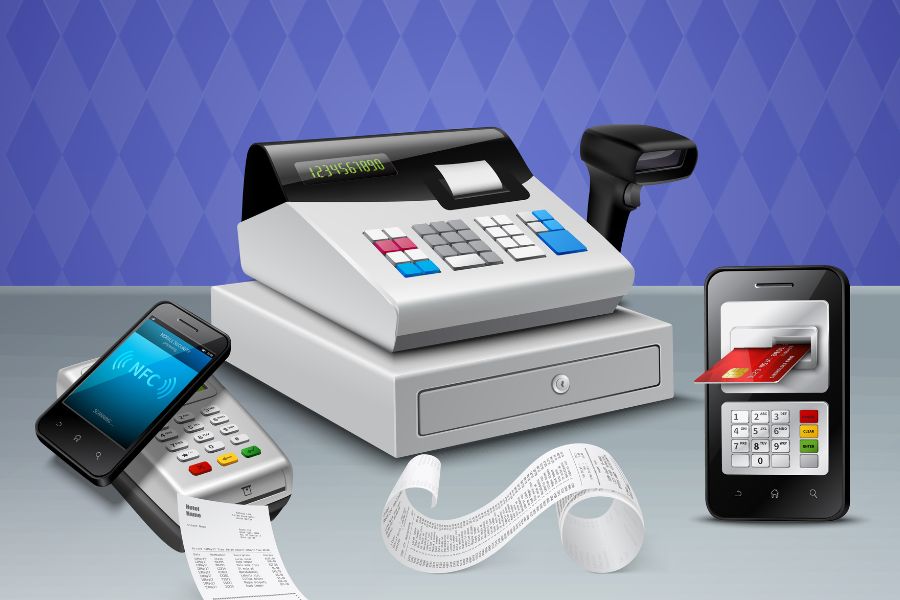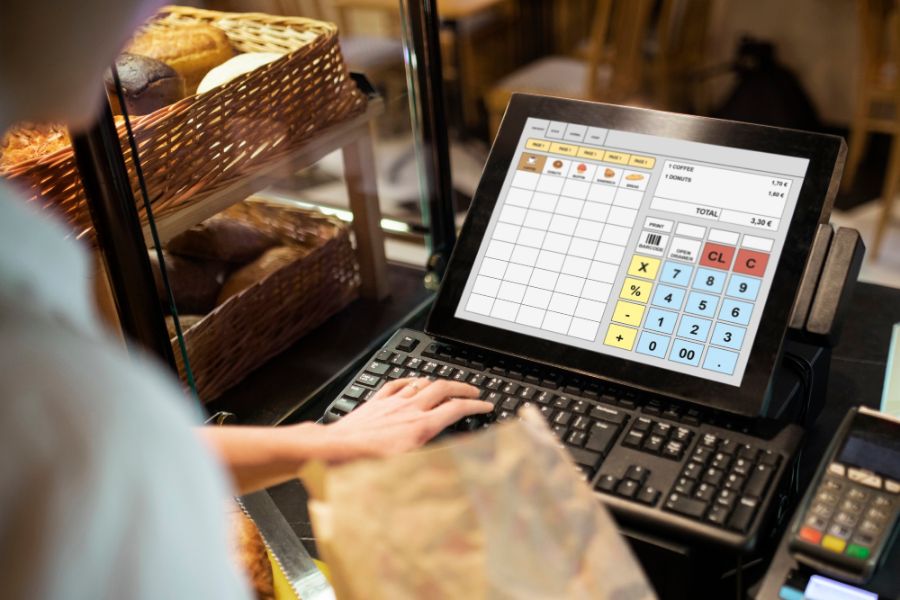The cash register you started with might still be sitting on your counter. Maybe it works fine. Maybe it doesn’t. Either way, hanging on to a legacy POS system could be holding you back more than you think.
New tools have changed the game, especially cloud-based point-of-sale systems. They run smoother, cost less to maintain, and let you manage sales from just about anywhere. So if your current setup feels like it’s stuck in the 90s, it might be time to look up.
Let’s break it down and see what you’re really working with.
Highlights:
- Legacy POS systems, once favored for their stability and offline functionality, were a go-to choice when businesses prioritized on-site control and had minimal integration needs.
- Today, legacy POS systems often fall short due to limited mobility, poor real-time data access, and high maintenance costs, driving more retailers to switch to cloud-based platforms for flexibility and scalability.
What is the Cloud?
The ‘cloud’ sounds fancy, but you’ve likely used it already. If you’ve ever logged into Gmail or stored files on Google Drive, that’s the cloud. It’s a network of remote servers that store and manage data online, so you don’t need to rely on your store’s physical machines.
Instead of saving everything on your computer, cloud systems keep it all on the internet. That means you can pull up sales reports from your phone, adjust your inventory from home, or check store activity while sipping coffee across town.
No cables. No clutter. Just data, anytime you need it.
Legacy POS Systems vs Cloud POS Systems: What’s the Difference?
Now that we know what the cloud is, let’s look at how it stacks up against legacy POS systems, also called traditional or on-premise setups. Both can help keep your store running, but they handle data in very different ways, especially when it comes to where and how your information is stored.
Legacy POS Systems
Legacy POS systems, also called traditional POS, keep all data stored locally on in-store servers and operate through a private internal network. Setting one up usually takes time and effort since it depends on heavy hardware that must be installed and wired at a fixed location.
Cloud POS Systems
In contrast, cloud-based POS systems store data online through remote servers instead of keeping it on-site. Think of it like mobile banking, you can check your balance or make a payment from anywhere. Likewise, staff using a cloud POS can manage sales and help customers from any spot in the store with an internet-connected device.
Pros and Cons of a Cloud POS System
One easy way to figure out which POS system fits your business best is to weigh the pros and cons of each. We’ll kick things off by looking at what’s good and what’s not about using a cloud-based POS.
Pros of a Cloud POS System
A cloud-based POS system can bring major benefits to retailers and store staff across many industries. Here’s a breakdown of the key benefits:
- More Flexibility: With wireless connectivity, cloud POS terminals aren’t locked to a counter. Staff can move freely, checking out customers, managing stock, or assisting on the floor.
- Cost-Efficient Setup and Operation: Cloud POS systems require less complex hardware and fewer installation steps. Legacy systems can cost over $15,000 just for hardware, according to FitSmallBusiness. Cloud POS is easier on your budget, with lower upfront costs and predictable monthly fees.
- Scales Easily: Adding more devices or opening a new location? It’s fast and simple with cloud POS. Since it often runs on tablets or mobile devices, you can expand without heavy infrastructure.
- Consistent Control Across Stores: Update product info, prices, or promotions once, and apply changes to every store in real time. No repetitive manual updates at each site.
- Remote Support and Automatic Updates: Tech support and software upgrades can be handled off-site, no waiting for someone to visit your store.
- Access Anytime, Anywhere: Check sales, inventory, or staff performance from your phone or laptop, whether you’re in-store, at home, or traveling.
- Smooth Integration with Other Tools: Connect your POS with accounting software, payroll tools, CRM platforms, and more. Everything works together to make operations simpler.
Cons of a Cloud POS System
Cloud POS systems offer plenty of perks, but they’re not without a few limitations. Here are some things to keep in mind:
- Internet Dependency: Since cloud POS runs online, your connection plays a big role. If the Internet goes down, some features may pause. That said, many cloud systems now come with offline modes. You can still process sales, print receipts, send orders, and take payments without skipping a beat.
- Device Limitations: While tablets are great for mobility, not every task works best on a small screen. More complex functions, like setting up detailed reports or managing large inventories, often still require a desktop or laptop.
- Security Concerns: Storing data online means it must be well protected. If your provider cuts corners on security, your info could be at risk. The good news? Reputable cloud POS vendors use strong encryption and layered defenses to keep your data safe.
Pros and Cons of a Legacy POS System
Just like cloud systems, traditional legacy POS setups come with their own upsides and downsides. Let’s look at some advantages store owners might still get from using a legacy POS system.
Pros of a Legacy POS System
- Easy to Get Used To: Since legacy POS systems have been around for decades, many long-time staff are already familiar with how they work.
- No Internet Needed: These systems run without relying on WiFi, which makes them useful for places with unstable or limited internet access.
- Handles Complex Setups: Large retail chains often stick with legacy systems because they support multi-location setups, though this usually comes with a high price tag.
Now let’s flip the script and look at the downsides of sticking with this older setup.
Cons of a Legacy POS System
- On-Site Repairs Only: When something breaks or needs updating, a technician usually has to come in person. That means more wait time and higher costs.
- Can’t Access Data Remotely: To check reports or manage your system, you need to be at the store. This becomes a hassle if you run more than one location.
- High Upfront and Maintenance Costs: Traditional systems come with steep setup fees, expensive hardware, licensing charges, and ongoing service costs. Cloud options? Usually way cheaper.
- Bulky and Stuck in Place: These systems aren’t built to move. Once they’re installed, they stay put, no flexibility for layout changes.
- Doesn’t Play Well with Others: Legacy tech wasn’t made to connect easily with modern tools. That means fewer integration options with accounting, inventory, or loyalty apps.
- Risk of Data Loss: If something goes wrong, like a power outage or physical damage, you’re on the hook. With no cloud backup, your sales and customer info could be gone for good.
Why Go with a Cloud-Based POS Instead of a Legacy System?
After looking at both sides, let’s talk about which POS setup really pulls ahead for today’s retailers.
For most stores, whether you’re running a single boutique or managing multiple locations, a cloud-based POS is the smarter pick. It’s made for businesses that want to grow, adapt quickly, and keep up with customer expectations. Below, we’ll break down the key reasons why switching from a legacy POS system to a cloud system makes solid business sense.
Cloud POS Is a Smarter Financial Choice
Let’s kick things off with one of the biggest wins: cost. Cloud POS systems tend to be much lighter on your wallet than legacy setups. Instead of shelling out for bulky hardware and pricey on-site maintenance, you just pay a monthly fee. Updates, fixes, and support? All handled remotely. If you’re running more than one store, this setup saves even more, since you don’t need to duplicate expensive gear across locations. It’s a smarter, simpler way to grow without blowing your budget.
Designed for Simplicity and Ease of Use
As more people get used to cloud tech in their daily lives, cloud POS systems are quickly becoming the go-to for store teams. They’re often easier to learn and use, especially compared to clunky, outdated legacy systems. That’s because they’re designed for real users, cashiers, sales associates, and store managers.
Many providers now use modern, familiar tools like iPads to run their systems. With Apple’s clean interface and smooth performance, staff can pick things up faster with less training. This means fewer headaches on the shop floor and a more efficient checkout experience from day one.
Run Your Store from Anywhere
Cloud POS systems give store owners serious flexibility. You don’t have to be on-site to stay in control. Want to check sales, adjust staff schedules, review inventory, or track payroll? You can do all that from wherever you are, on your phone, tablet, or laptop.
Let’s say you’re relaxing at home and decide to tweak pricing across multiple store branches. No need to drive back. You can update everything remotely in real time. Legacy systems can’t compete with that kind of convenience.
Built-In Security You Can Trust
Retailers today need to be confident that their data is protected. The good news? Most cloud POS providers take security seriously. These systems are built with strong protections in place for both business and customer information.
On top of that, updates are handled remotely, no tech visit required. Providers constantly improve their systems and push out security patches without disrupting your day. So while you’re busy running your store, your data stays locked down and in safe hands.
Helps You Serve Customers Better
Cloud-based POS systems are built to support busy retail teams and create a smoother shopping experience. They speed up transactions, help reduce errors, and keep everything running efficiently, whether you’re on the sales floor or behind the counter.
For example, staff can use mobile devices to check out customers from anywhere in the store. That means no more long lines at a fixed register. Orders go through instantly, and inventory updates in real time. This not only saves time but also helps staff focus more on helping shoppers.
And if your internet goes out? No panic. Most cloud POS systems have an offline mode that still lets you process payments and print receipts. Sales don’t stop just because the Wi-Fi does. Your store stays open, and your customers leave satisfied.
Grows Alongside Your Business
As your business grows, a cloud-based POS can grow with it, something traditional systems often struggle to keep up with. Cloud POS platforms work with lightweight, affordable tech like tablets or smartphones. That makes setup simple and much cheaper than the bulky hardware needed for legacy POS systems.
Opening a second location? No problem. With a cloud POS, everything from your product catalog to customer data is already stored online. Just log in from your new device, and your store’s setup is ready to go, no need to re-enter info or rebuild your system from scratch. That kind of plug-and-play setup is a huge time-saver for growing businesses.
When picking your next POS, take time to compare your options. Legacy systems may still have a place, but cloud-based platforms offer flexibility, lower long-term costs, and smoother multi-store management. If expansion is part of your plan, a cloud solution just makes sense.
Meet ConnectPOS: Your Future-Ready Cloud POS System
If you’re thinking of moving away from your outdated legacy POS, ConnectPOS is worth a serious look. It’s a leading cloud-based POS solution trusted by 12,000+ retailers and 200+ global partners. Whether you’re running a single store or managing a chain, ConnectPOS helps you sell smarter, faster, and from anywhere.
Here’s what makes ConnectPOS stand out:
- Omnichannel Experience: Sync online and offline sales in real time, across locations and platforms.
- Mobile POS: Let staff sell on the go with tablet-ready checkout, mobile inventory tools, and fast barcode scanning.
- Customizable Checkout: Tailor everything from screen layout to payment flows for your store’s unique vibe.
- Real-Time Analytics: Get instant insights on sales, staff, and inventory to make data-backed decisions without delay.
- Inventory Management: Track stock across warehouses, stores, and online platforms with total accuracy.
- eCommerce Integration: Works seamlessly with Shopify POS, Magento POS, BigCommerce POS, and other e-commerce POS.
- Multi-Device Support: Run on desktop, tablet, smartphone, whichever suits your setup best.
- Customer Loyalty Tools: Built-in reward programs, customer profiles, and promotion setups to keep people coming back.
- Self-Service Kiosks: Let shoppers check out by themselves with secure QR/barcode scanning and e-receipts.
- Flexible Payments: Accept all major methods, including split bills, partial payments, and multi-currency.
- Secure Cloud Storage: Your data is backed up, encrypted, and accessible anytime, anywhere.
- Offline Mode: Keep selling even when the internet’s acting up.
- API & Customization: Plug in third-party apps or build your own features using open APIs.
Need to upgrade your legacy POS? ConnectPOS was built for that. It’s designed to migrate smoothly and scale as you grow. You can be chasing real-time control, better customer service, or smoother operations – ConnectPOS makes the shift to cloud POS a no-brainer.
FAQs: Cloud POS vs Legacy POS System
1. What is a legacy POS system?
A legacy POS system is an older type of checkout system that stores all its data on-site, usually on computers or servers inside the store. These systems often need a lot of hardware and can’t be accessed from outside the store.
2. Are cloud-based POS systems secure?
Yes, cloud-based POS systems are very safe. Good companies use strong tools like passwords and data locks to keep your information safe. They also save your data automatically so you won’t lose it if something goes wrong with the computer.
3. Is it expensive to switch from a legacy POS system to a cloud-based solution?
It might cost a bit at first to change, but cloud-based POS systems usually don’t need as much equipment. That means you spend less money getting started. Later on, you can also save money because you don’t need to fix things as often, and updates happen automatically.
Final Thoughts
If your current POS feels slow, outdated, or just plain frustrating, it’s probably time for a change. Legacy POS systems were great, but that was 20 years ago. Today, they’re more of a roadblock than a resource. They tie you down with clunky hardware, limited access, and high maintenance costs. And let’s be honest, trying to get real-time data from a system that can’t even sync with your eCommerce store? That’s a headache you don’t need.
Cloud POS systems like ConnectPOS aren’t just modern, they’re practical. You can access your business from anywhere, scale without stress, and give customers a better experience. Whether you’re launching your first store or managing a whole retail chain, ConnectPOS fits right in. It grows with you, adapts to your workflow, and keeps your data safe and ready 24/7. In short, switching to cloud POS isn’t just an upgrade. It’s a smart move for the future of your business.
Still have questions? Or maybe you’re ready to make the switch? Get in touch today, we’re here to help.



